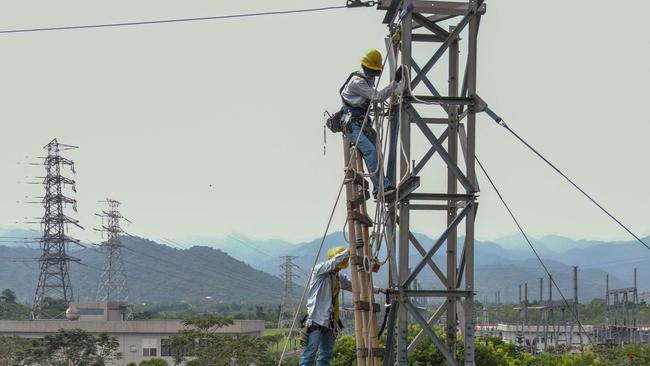
While Taiwan’s ruling Democratic Progressive Party is officially committed to phasing out its nuclear power plants, with one closing down last weekend, the politicians in the energy-hungry island are debating whether to reverse the decision.
Authorities are also keeping a close eye on future technologies, including small nuclear reactors.
If all goes as officially planned, Taiwan will become nuclear-free by May next year with the closing of its final nuclear reactor.
But as the island’s energy demands are increasing to meet the needs of its industry, particularly its power-hungry semiconductor industry, which dominates the world in high-end chips, there are new questions being raised about whether nuclear could still have a role in its energy mix.
With the self-ruled island under increasing pressure from China – with some fearing the threat of a potential blockade – some politicians are pushing the government to reconsider its commitment to close down its remaining nuclear plant.
The debate comes as Australia’s Opposition Leader, Peter Dutton, has proposed the idea of setting up small modular reactors (SMRs) in Australia.
It’s an idea that is radical for Australian voters and deemed far too expensive by many, but it is a concept that is being closely watched globally, particularly in energy-poor Asia.
Taiwan’s potential interest in SMRs was discussed in a briefing for foreign journalists – including The Australian – visiting Taiwan last week, by the Industrial Development Administration (IDA), an arm of its Ministry of Economic Affairs.
A journalist from South Korea, which is also closely watching the potential of SMR technology, asked the secretary-general of the IDA, Lin Der-Sheng, if Taiwan was considering using SMRs.
“In terms of the SMR technology, our Ministry of Economic Affairs does closely track international technological trends in this regard,” Lin replied.
“As far as we understand now there have been no commercial operations of SMR technology.
“The technology is not mature enough, but we will follow very closely such technological trends in the world.”
Asked about the impact of the planned closure of the latest reactor, Taiwan’s Premier, Cho Jung-tai, told reporters on July 17 that his government was still open to using nuclear power in the future.
“If new nuclear energy technologies can address the issue of nuclear safety and nuclear waste, and are accepted internationally, then, of course, we would be very open to discussing the matter,” Cho said.
In the meantime, he said the government would focus its efforts on reducing the use of coal and expanding the use of natural gas.
Nuclear power has played an important role in Taiwan’s energy mix for the past 40 years.
Taiwan’s commitment to shutting down its nuclear power plants followed the accident at the Fukushima power plant in Japan in 2011.
The DPP was first elected to power in January 2016, with then president Tsai Ing-wen promising to phase out nuclear power by 2025.
She set a long-term target for the island’s energy mix to be made up of 50 per cent natural gas, 30 per cent coal and 20 per cent renewable energy.
The latest step in the DPP’s plan to exit nuclear power took place last weekend, when Taiwan’s national power company, Taiwan Power, stopped operating the 936MW first reactor of the Maanshan-1 nuclear power plant, in Pingtung County, on the southern tip of the island.
The reactor was first commissioned on July 27, 1984.
Its second remaining unit, 938MW Maanshan-2, is expected to be stopped after 40 years of operations on May 18 next year.
Nuclear accounted for 6 per cent of Taiwan’s power mix last year, with nearly 18 TWh.
The closure of the plant last weekend resulted in nuclear’s role in Taiwan’s energy mix falling to 2.8 per cent.
The opposition party supports the use of nuclear power, arguing in favour of restarting nuclear reactors.
The issue of whether to reverse the proposed closure was hotly debated in its legislature in July, but no vote was taken.
So far Taiwan’s renewable energy, which has a heavy reliance on offshore wind, makes up only 12 per cent of total energy consumption, with the government targeting it to rise to 25 per cent by 2030.
Meanwhile, while debate continues in Taiwan over the future of nuclear, across the Strait, China is starting work on two new nuclear reactors, in Ningde in Fujian province, and Huaneng in Shandong province.
This will bring the total number of plants under construction in the country, which already has 55 nuclear power plants in operation, to 26.
While Dutton has kicked off a new debate about the future of nuclear in Australia, Taiwan’s phasing-out of nuclear and its increasing energy demands, will result in it becoming more economically dependent on Australian resources.
LNG giant Woodside signed its first long-term agreement to sell gas to Taiwan in July.
In an agreement with Taiwan’s state-owned oil and gas company CPC, Woodside agreed to supply six million tonnes of LNG over 10 years. The deal could result in Woodside selling another 8.4 million tonnes of LNG to CPC for another 10 years, from 2034 to 2043.
Announcing the deal, Woodside CEO Meg O’Neill said the agreement was a first for Woodside and “another demonstration of the ongoing demand for Australian LNG in Asian markets”.
Taiwan is currently building 8GW of gas-fired power plants, with another 1.9GW planned.
But critics argue that increasing use of gas will increase costs and also carbon dioxide emissions.
In the short term, gas will become an increasing part of Taiwan’s energy mix.
But the combination of energy demand, rising costs and the need to meet net zero commitments by 2050 has been keeping the nuclear debate in Taiwan alive.
As other countries face similar challenges, Taiwan’s energy decisions will be closely watched, including in Australia, its biggest single supplier of energy.
Glenda Korporaal travelled to Taiwan as a guest of the Taiwanese government.




As it closes down its 40-year-old nuclear power plants, Taiwan is grappling with its energy future – with nuclear still a possibility to meet its growing energy demands.